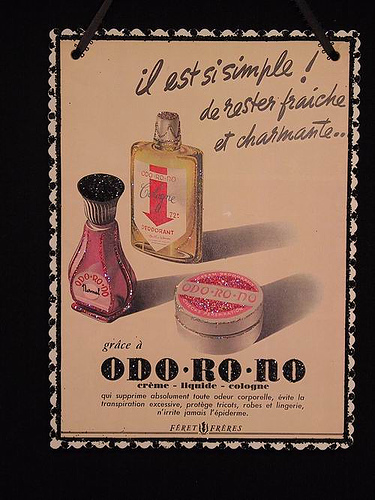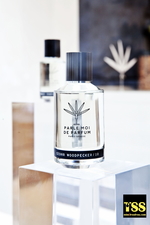Olfactory Bodisme Exhibition at the V & A {Scented Paths & Fragrant Addresses} {Perfume Ads}

Breakdancers, 1986 © PYMCA via Fashion V Sport
The Victoria & Albert Museum in London is organizing an exhibition on fashion and sports called Fashion V Sport which started on the 5th of August 2008 and will run until the 4th of January 2009. Within it, sensory artist Sissel Tolaas has set up an olfactory thread that runs through the exhibit, creating a second invisible exhibition entitled Bodisme only discernable to the nose, thus developing further her work on human body odor.
The scent installations on display are to be found in each of the four sections of the exhibition:
"DARE A 'clean' sweaty body without bacterial interaction
DISPLAY A sweaty body overlaid with deodorant/ artificial smells
PLAY A sweaty body's unique 'smell fingerprint' that carries natural
messages in pheromones, bacterial interaction,
DESIRE A custom-made simulated body smell as a base scent with added
molecules on top to communicate the desired message"...

Odo-Ro-No ad from the 1940s via Design Cracker
"We take for granted that clothing our bodies is a sophisticated tool to visually convey our
moods, status and personality. However, there is another important mode of
communication involving our bodies that takes place subliminally every day. In an
invisible process, exchanges of information carried by sweat communicate the state of
our health, our emotions, sexuality, age, fitness, and aggression.
In the West since antiquity there have been concerns with body smells and methods to
suppress them. Aristotle posed the question in Problemata,
"Why has the armpit a more unpleasant odour than any other part of the body?"
'Body odour' or 'B.O' is a smell produced by a person that we associate with sweating.
Sweat alone does not give off a smell, because it is just water and salts expelled by the
sweat glands to control body temperature. The bacteria on a person's skin mix with
sweat to create the smell that we have defined in the West as 'B.O.'
This term was invented as a negative expression by a group of American advertisers in
the 1920's.They encouraged women to buy their product 'Odo-Ro-No' by highlighting the
women's insecurities with themselves and the world around them; only the advertised
product could rescue them from the potential social shame of 'body odour'. Because
most people are concerned about how they look and smell, these advertisers were
phenomenally successful. They tapped into a deeply rooted fear of social exclusion." (...)
"We make sensory decisions based on smell within seconds. New research shows that
some people's smell is highly sensitive to a component of body odour called
androstenone. Androstenone is a human pheromone, a chemical attractant found
amongst body secretions such as perspiration. Men release much larger quantities of
androstenone than women; as a result they are more likely to be judged by their smell.
The study found fifty percent of the population cannot smell androstenone at all, and one
half of the rest smell only a whiff. Those who are able to experience the pheromone do
not consciously like it and compare it to urine or perspiration. The research went on to
show a strong correlation between the ability to smell androstenone and the smeller's
judgment of that person.
We are so used to the way our smells are organised and regulated for us that we don't
notice it anymore. Yet in the past, smell served an important function to guide us through
the world by letting us know whether something was fresh and safe or foul and
dangerous. Societies frequently load symbolic values and code onto odour, using it as
one of many ways to manage and enforce group cohesion/ division, hierarchy and
gender distinctions. The idea of social classification through smell is illustrated by the
proposal of a French perfumer in 1709 that different classes be scented appropriately.
There would have been a royal perfume for the aristocracy and a bourgeois perfume for
the middle classes, but only disinfectant for the poor! It is ironic that in our deodorised
modern world the power lies with odour-neutralised businessmen rather than with those
intensely perfumed, like the kings of the past."









